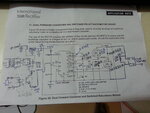nehe bhimaji
Newbie level 4
Dear All
I am using Mosfet in Dual feed convertor mode for driving Inductor coil for Mechanical Vibration as given in AN of IR2110 . I Modified the connection and Ckt is attached here.The Circuit is driven by the PWM pulses from Arduino UNO with default PWM frequency 455Hz. As I start it Both Mosfets and IR2110 get Blast.I remove the Q1 Q2 D2 and R then it start working
Even though I have facing following problem
As i Increases the duty cycle of PWM for more Power then Mosfets and IR2110 gets Damaged. I have dought that My Bootstrap Capacitor is too small and there should be resistor between IR2110 HO LO and gate of the mosfet.
Please help if i am correct or Not
Thanks
I am using Mosfet in Dual feed convertor mode for driving Inductor coil for Mechanical Vibration as given in AN of IR2110 . I Modified the connection and Ckt is attached here.The Circuit is driven by the PWM pulses from Arduino UNO with default PWM frequency 455Hz. As I start it Both Mosfets and IR2110 get Blast.I remove the Q1 Q2 D2 and R then it start working
Even though I have facing following problem
As i Increases the duty cycle of PWM for more Power then Mosfets and IR2110 gets Damaged. I have dought that My Bootstrap Capacitor is too small and there should be resistor between IR2110 HO LO and gate of the mosfet.
Please help if i am correct or Not
Thanks
